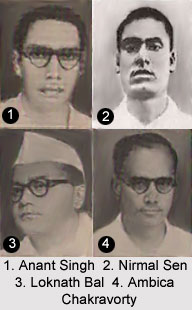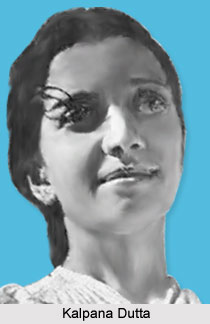 The members of the Indian Republican Army took several preparations for Chittagong Armoury Raid Case in the year 1930. The members of the Indian Republican Army included their leader Masterda Surya Sen and other prominent members like Kalpana Dutta, Pritilata Waddedar, Anand Gupta, Jiban Ghoshal, Ananta Singh, Tarakeswar Dastidar, Harigopal Bal (Tegra), Ardhendu Dastidar, Sasanka Datta, Naresh Roy, Ambika Chakrobarty, Subodh Roy, Nirmal Sen, Lokenath Bal and Ganesh Ghosh. The Chittagong Revolutionary Group was an ideal combination of planners and executors. Further more, some of the members of the group achieved expertise in the usage of arms and weapons, while other members were skilled in political activities. The armoury raid in Chittagong was one of the most amazing and brave revolutionary activities in the history of the Indian freedom struggle that was devised by the youths of the region. The attack was conducted on 18th April 1930 to raid the armoury of police and auxiliary forces from the Chittagong in Bengal province during the rule of the British Empire in India.
The members of the Indian Republican Army took several preparations for Chittagong Armoury Raid Case in the year 1930. The members of the Indian Republican Army included their leader Masterda Surya Sen and other prominent members like Kalpana Dutta, Pritilata Waddedar, Anand Gupta, Jiban Ghoshal, Ananta Singh, Tarakeswar Dastidar, Harigopal Bal (Tegra), Ardhendu Dastidar, Sasanka Datta, Naresh Roy, Ambika Chakrobarty, Subodh Roy, Nirmal Sen, Lokenath Bal and Ganesh Ghosh. The Chittagong Revolutionary Group was an ideal combination of planners and executors. Further more, some of the members of the group achieved expertise in the usage of arms and weapons, while other members were skilled in political activities. The armoury raid in Chittagong was one of the most amazing and brave revolutionary activities in the history of the Indian freedom struggle that was devised by the youths of the region. The attack was conducted on 18th April 1930 to raid the armoury of police and auxiliary forces from the Chittagong in Bengal province during the rule of the British Empire in India.
Satish Chandra Chakravarty, who was a lecturer at the Krishna Nath College at Berhampore, was also one of the key members in a revolutionary group. He inspired Surya Sen with the ideals of revolution and patriotism, who eventually vowed to dedicate his life in forming up a revolutionary group in Chittagong and take active participation in the Indian freedom struggle. Moreover, Hemendralal Mukhoti, one of the fugitives of the Barisal Conspiracy Case, also motivated Surya Sen, Ambika Chakrabarti and some other local men revolutionary ideal. During the year 1925, while most of the members of the 2 major revolutionary groups of Bengal, Jugantar and Anushilan Samiti, were imprisoned, the Chittagong revolutionary group remained active. Nirmal Sen gained expertise in smuggling arms and ammunitions from the Far East to Chittagong. After the British Intelligence Division learnt of the smuggling process, Nirmal Sen was arrested while on a tour to Chittagong in 1926. Surya Sen and other members recruited several young and teenaged boys who were interested in joining the revolutionary movement during 1928.
Surjya Sen was employed as a teacher and thus received the reverential honorific of Master-Da. He taught several of his students about his revolutionary ideals and inspired them to join the movement. By the year 1918, Master-Da Surya Sen, along with Charu Bikash Datta, Ambika Chakrabarti and others, established a separate revolutionary group in the region of Chittagong. The group aimed at gaining independence from the British administration in India through aggressive and violent revolutionary means. This idea was already intensely entrenched in the mind of the youths at the time. Although the initial political assassination of a British official, Chairman of Plague Commission- W.C.Rand, occurred in Poona (now Pune) in 1897, the idea of armed struggle for national freedom developed and thrived in Bengal. Such movements of cultural awakening were initially led by various historical personalities like Raja Ram Mohan Roy during the mid-19th century. Moreover the famous novel titled Ananda Math, authored by Bankim Chandra Chattopadhyay, was considered as a Bible for the Indian revolutionaries.
The natives of the country were prohibited from possessing weapons and fire-arms through the Arms Act of 1878, although the British Indian army, officials and other Europeans in the country retained the most sophisticated and technically advanced weapons that existed at the time. This Act motivated the revolutionaries further for military and physical prowess in order to challenge and confront the British Empire in India. The members of Surya Sen`s Indian Republican Army were also motivated by the sacrifices of Prafulla Chaki and Khudiram Bose, who bombed a carriage in Muzaffarpur with the objective to assassinate Douglas Kingsford, the former Chief Presidency Magistrate of Calcutta. They were also encouraged by the sacrifices of Kanailal Dutt and Satyen Bose. But the Indian Republican Army never aimed for political murders of British officials. Even during extensive arrests and detentions under a range of oppressive laws, Surya Sens`s group never lacked members as new recruits continuously joined the armed revolt movement.
The initial stage of the revolutionary freedom struggle culminated with the conclusion of the Great War in the year 1918. Most of the leaders in the Presidency of the Anushilan Samiti and the Jugantar party were arrested, hanged or sentenced to transportation for life to Port Blair. During this time the revolutionary activities halted, but various groups established by young natives throughout Bengal remained dedicated towards armed revolution as they were confirmed that it was the only way of attaining independence from the British rule. Master-Da Surya Sen, along with his associates started from the base and developed their revolutionary ideals. The group aimed to affiliate with the Jugantar party or the Anushilan Samiti. Consequently, Surya Sen and most of his friends became a member of the Jugantar party, as it was not much centralized and individual groups had significant independence in its flexible structure.
All detenus under the Defence of India Act were released, along with the leaders of the national revolutionary movements, after the Royal Proclamation in 1919. The members of the Jugantar Party in Bengal joined the Indian National Congress district committees and operated as volunteers. In this period, Surjya Sen, Ambika Chakrabarti, Ananta Singh, Ganesh Ghosh and their other associates came under the leadership of J.M. Sengupta, who was an eminent lawyer and a follower of Mahatma Gandhi. As the Chittagong revolutionary group became a part of the Non Cooperation Movement of Gandhi, they extremely disappointed after Mahatma Gandhi abolished the movement on 11 February 1922, due to the violence in Chauri Chaura. After this, Surya Sen adopted the decision to recommence violent methods during the Chittagong Congress of April 1922. The Indian Republican Army was in the second phase of the movement and aimed to gather finance by robbing the British administration, purchasing arms and ammunitions, manufacturing bombs, developing associations with other groups in Bengal to conduct synchronized uprisings.
In the year 1923, some of the prime members of the group like Ananta Singh, Ganesh Ghosh and Premananda Datta established a physical training club in Chittagong with a pure revolutionary objective. During the end of the same year, Ananta Singh and other members robbed a Railway clerk of a huge sum and the amount was utilised by Ambika Chakrabarti to buy weapons.
 Later while escaping from an arms depot and hideout, Surya Sen and Ambika Chakrabarti were arrested by the British Police. In the next few months, Ananta Singh was also detained in Howrah. But the jury in the Court acquitted all the 3 accused members. Nogendra Sen, a former soldier, provided fundamental military training to the members of the Chittagong revolutionary group who conducted the Chittagong armoury raid case. Several members were arrested under the ordinance, but Master-Da Surya Sen managed avoid the British police for almost 2 years. He also supported in the formation of the Hindustan Republican Association (HRA). Surya Sen was finally arrested in October 1926.
Later while escaping from an arms depot and hideout, Surya Sen and Ambika Chakrabarti were arrested by the British Police. In the next few months, Ananta Singh was also detained in Howrah. But the jury in the Court acquitted all the 3 accused members. Nogendra Sen, a former soldier, provided fundamental military training to the members of the Chittagong revolutionary group who conducted the Chittagong armoury raid case. Several members were arrested under the ordinance, but Master-Da Surya Sen managed avoid the British police for almost 2 years. He also supported in the formation of the Hindustan Republican Association (HRA). Surya Sen was finally arrested in October 1926.
After a period of 2 years, Sen and other prominent members of the Indian Republican Army were released and gathered in the town of Chittagong. They decided to operate independently and distinctly to successfully carry out a remarkable uprising. It was further decided that the group will not be involved in any robberies, arms smuggling and they would not depend on the renowned leaders in Calcutta either. The group resolved to produce their own funds and construct an army that would share their ideals of national independence through armed revolution. Master-Da Surya Sen was determined to conduct small revolutionary activities that will be carried out successfully, instead of wasting more time on attaining an all India revolt.
The leaders of the Chittagong revolutionary group, Indian Republican Army, recruited new members and trained them in order to plan every detail and take proper preparations for Chittagong Armoury Raid.



















